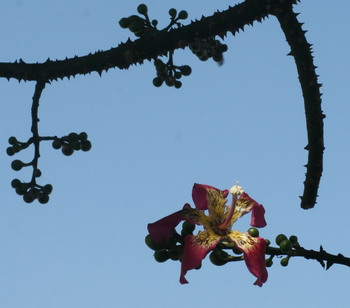Los Angeles is home to a surprisingly large number of newcomers to the bird world – wild parrots ( parrots and parakeets, to be more precise). According to some ornithologists nearly 5,000 of these birds live in the urban landscape. As parrots do not occur naturally in California, this population arose from birds who either escaped captivity or were thrown out by their owners.
Interestingly enough these parrots are confirmed city dwellers. The reason why they have not (yet) moved out into less populated landscapes is quite simple: Parrots are not native birds, they are used to fruits, trees and shrubs of their native tropical home, which have been planted in large numbers in our urban and residential areas. So they stay where the food is, which is definitely not out there in the countryside.
One tree these birds particularly like is the Floss Silk Tree (Chorisia speciosa):

This tree itself, a native of the tropical forests of South America, is quite a newcomer to the city; it has been planted only since about 30 to 40 years. The flowers are very beautiful, the trunk and branches look a bit forbidding once they reach maturity, because they are covered with thick conical prickles, used to store water. The fruit looks like huge avocados or gigantic pears and the parrots just love them.
A fruit-bearing Floss Silk tree can be detected by the noise of the parrots having a meal, digging into the pods and gobbling up the seeds, while telling each other in between bites in loud parrot screeches: “It’s just like back home, isn’t it?!”
I’d love to see a photo of the whole tree. In the photos of SF was a very strange shrub none of us could identify. It had leaves somewhat like a cross between elephant ears and a philodendron. It was growing at a waterside. It had a very strange “fruit”. This is it. Do you know what it is.
I’ve seen maybe one parrot and several parakeets in the “wild” here. They came to our bird feeders when I had them. It was somewhat startling.
If you go here
http://209.85.141.104/search?q=cache:u8VXaNkrMRQJ:www.tfts.org/chorisia.htm+floss+silk+tree+los+angeles&hl=en&ct=clnk&cd=10&gl=us&client=firefox-a
and click on the tiny photo “street scene”, then you can see one of the trees.
I have no idea what the plant in SF is. I showed the photo to William, who immediately said ‘sure, I’ve seen those around,” but unfortunately he does not know the name. A trip to a botanist at your local university might be in order.
One parrot? Several parakeets? Around here they fly in swarms, sometimes one sees as many as 20 or 30 at the same time. God, those are noisy birds! Can you imagine – flying and chattering at the same time?
Do you have grackles? They are a big black noisy raucous bird. I have seen hundreds of them roosting in trees in the area in the evenings.
Yes, we do have grackles, but interestingly enough not in the city. To see them one has to drive out towards the more arid regions. That’s only 20 miles or so, but the environment changes dramatically there and is much more to the liking of the grackles.
The SoCal grackle is somewhat smaller than the ones we see in Nevada and Arizona. Those are huge!
They are rather belligerent rascals, but for some reason I have a fondness for them. Hearing them always reminds me of San Antonio and my childhood. We have them here, though. In some places, they have become a real nuisance. On the University of Texas campus, people have to resort to carrying umbrellas at times or risk being shit-bombed. Of course, the grounds people wouldn’t dare harm the grackles, so trying to discourage them from roosting on the campus is an on-going battle. The grackles are winning.